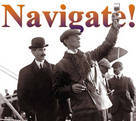|

 Up
Up 
 1905-15 Bent-end
1905-15 Bent-end
Propellers 
(You are here.)



  Need
to Need
to
find your
bearings?
Try
these
navigation aids:
If
this is your first
visit, please stop by:
Something
to share?
Please:



|
|
Available in Française, Español, Português, Deutsch, Россию,
中文,
日本, and others.
 arly
in their 1904 test flights at Huffman Prairie, the Wright brothers
realized that their round-end, straight propellers were not
producing as much thrust as the math said they should. The props were long,
slender – and flexible. When turning at speed (400 to 500 rpm), the
straight blades bent slightly toward the trailing edges, assuming an
S-shape. arly
in their 1904 test flights at Huffman Prairie, the Wright brothers
realized that their round-end, straight propellers were not
producing as much thrust as the math said they should. The props were long,
slender – and flexible. When turning at speed (400 to 500 rpm), the
straight blades bent slightly toward the trailing edges, assuming an
S-shape. This bending at speed put the leading edge of each blade
under tension and the trailing edge under compression. This in turn
caused the blade to buckle slightly, increasing the pitch –
the angle at
which it met the air. Consequently, the blade lost thrust at speed.
To prevent this, the Wright brothers decided to widen the blades,
adding stock at the propeller's center of pressure where it was most
important to keep the blade at the proper angle. The result was an
elongated diamond or spade-shaped blade with squared ends. This
worked, but only partly – the forces of tension and compression at
the edges still caused the blade to change pitch.
Rather than strengthen the propeller yet again, the Wrights decided
instead to
design propellers that would balance the forces to retain
the proper pitch. Experimenting with the
spade-shaped blades, they added triangular pieces of wood (nicknamed
"little jokers") to the trailing edges, changing the way the
compressive and tensive forces were distributed. This did the trick
– at speed, the prop remained at the proper
pitch and
produce the predicted thrust.
Next, they carved props with the little jokers incorporated into
the blades. The resulting set of propellers looked as if they were
pre-bent. Later, when the Wrights began to make public
demonstrations, observers described these as "bent-end" propellers
and the name stuck.
The Wrights carved a set of bent-end propellers for the 1905
Flyer and found that they produced 210 pounds of thrust (compared to
the 120-130 pounds produced by the 1903 props). Afterwards, they used
these distinctive bent-end propellers on all their aircraft up until
1916. They were able to improved the efficiency of the props from
66% in 1903 to 78% in their commercial aircraft. By comparison,
modern propellers convert 82-83% of their rotational energy to
thrust.
References:
- Orville Wright, deposition in Montgomery vs. the United States, 2 Feb 1921
- McFarland, Marvin W. (ed) The papers of Wilbur and Orville Wright. McGraw-Hill Book Co.,
New York, 1953, p 1214-1215.
- Lippincott, Harvey H. Propulsion System of the Wright Brothers. In Wolko, Howard S.
(editor), The Wright Flyer, an Engineering Perspective. The Smithsonian Institution Press,
1987, pp 79-82; 86.
[Submitted by Joe W. McDaniel]
|

The 1904 Wright Flyer II had straight propellers with rounded ends,
much like the props on the 1903 Flyer I.
|

The Wrights noticed that when these long propellers revolved at
flying speed, they flexed and bent. This in turn caused the blades
to increase pitch.
|